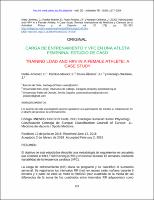Please use this identifier to cite or link to this item:
https://repositorio.usj.es/handle/123456789/513
| Title: | Carga de entrenamiento y VFC en una atleta femenina: estudio de caso |
| Other Titles: | Training load and HRV in a female athlete: a case study |
| Authors: | Nieto-Jiménez, Claudio


Mainer Pardos, Elena 


Ruso-Álvarez, José Francisco 

Orellana, José Naranjo 


|
| Keywords: | Actividad simpática-parasimpática; Trail Runners; Ironman; Mujer; Sympathetic and parasympathetic Activity; Trail Runners; Ironman; Female |
| Issue Date: | 2019 |
| Publisher: | RED IRIS |
| Citation: | Nieto-Jiménez, C.; Pardos-Mainer, E.; Ruso-Álvarez, J.F. y Naranjo-Orellana, J.(2020)Training Load and HRV in a Female Athlete: A Case Study. Revista Internacional de Medicina y Ciencias de la Actividad Física y el Deporte vol. 20 (78) pp. 321-333 |
| Abstract: | El objetivo de este estudio fue describir una metodología de seguimiento en una atleta que combina el Ultra Trail Running (UTR) y el Ironman durante 16 semanas, mediante variabilidad de la frecuencia cardiaca (VFC). La carga de entrenamiento (CE) diaria se programó y se cuantificó el sumatorio semanal. Se registraron los intervalos RR (ms) en reposo cada mañana durante 5 minutos y a partir de ellos se midió la RMSSD (raíz cuadrada de la media de las diferencias de la suma de los cuadrados entre intervalos RR adyacentes) como medida de la actividad parasimpática y el índice de estrés (SS) como actividad simpática. Los registros diarios de VFC matutinos parecen ser una forma útil para monitorizar el estado de equilibrio simpático-parasimpático en deportistas antes de abordar las sesiones de entrenamiento. Esta monitorización serviría para detectar precozmente estados de fatiga y para poder monitorizar la planificación de las cargas |
| Description: | The purpose of this study was to describe a follow-up methodology in a female athlete who combines Ultra Trail Running (UTR) and Ironman during 16 weeks, using Heart Rate Variability (HRV). The daily training load (TL) was previously programmed and the weekly summation was recorded. The RR (ms) intervals at rest were recorded every morning for 5 minutes. The RMSSD (root mean square of the successive differences between adjacent RR intervals) was measured as an index of the parasympathetic activity and the stress score (SS) as a measure of sympathetic activity. Daily HRV morning records appear to be a useful way to monitor sympatheticparasympathetic balance in athletes before tackling training sessions. This monitoring would serve to detect early fatigue states and to be able to monitor the planning of the loads. |
| URI: | https://repositorio.usj.es/handle/123456789/513 |
| ISSN: | 1577-0354 |
| Appears in Collections: | Artículos de revistas |
Files in This Item:
| File | Description | Size | Format | |
|---|---|---|---|---|
| CARGA DE ENTRENAMIENTO Y VFC EN UNA ATLETA FEMENINA.pdf | 303,21 kB | Adobe PDF |  View/Open |
This item is licensed under a Creative Commons License

